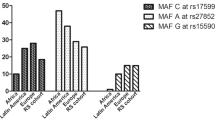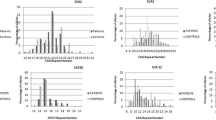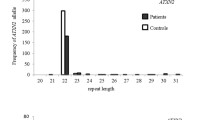Abstract
Spinocerebellar ataxia type 3, or Machado–Joseph disease (SCA3/MJD), is caused by an expansion of CAG repeats, which is inversely correlated to age at onset (AO) of symptoms. However, on average, just 55.2% of variation in AO can be explained by expansion length. Additional modulators, such as polymorphic CAG tract in ATXN2 gene, can raise to 63.0% of the variation in AO. A sequence variation (rs3512) in FAN1 gene has previously been shown to be associated with late AO in Huntington’s disease and polyglutaminopathies associated to ataxia. In the present study, genotype frequency of rs3512 was demonstrated in a cohort of SCA3/MJD patients from South Brazil, and these data were correlated to AO. The disease started 2.44 years earlier in subjects with the G/G genotype when compared to those subjects carrying the same CAGexp length at the ATXN3 gene and other genotypes (C/G and C/C) at rs3512. Placing together data on rs3512 genotype with data on CAG tract in ATXN2, AO of patients with G/G genotype was 2.58 years earlier, and a delay of 4.25 years was observed in patients that carry a short ATXN2 allele. Data presented here add further insights on the contribution of other factors in AO of SCA3/MJD beyond the causal mutation. Thus, well-known modifiers can help to unveil new ones and, as a whole, to better elucidate the mechanisms behind disease onset.



Similar content being viewed by others
References
Abraham, K. J., Chan, J. N., Salvi, J. S., Ho, B., Hall, A., Vidya, E., et al. (2016). Intersection of calorie restriction and magnesium in the suppression of genome-destabilizing RNA–DNA hybrids. Nucleic Acids Research,44, 8870–8884.
Bettencourt, C., Hensman-Moss, D., Flower, M., Wiethoff, S., Brice, A., Goizet, C., et al. (2016). DNA repair pathways underlie a common genetic mechanism modulating onset in polyglutamine diseases. Annals of Neurology,79, 983–990.
Bettencourt, C., Raposo, M., Kazachkova, N., Santos, C., Kay, T., Vasconcelos, J., et al. (2012). Sequence analysis of 5′ regulatory regions of the Machado–Joseph disease gene (ATXN3). Cerebellum,11, 1045–1050.
de Castilhos, R. M., Furtado, G. V., Gheno, T. C., Schaeffer, P., Russo, A., Barsottini, O., et al. (2014). Spinocerebellar ataxias in Brazil—Frequencies and modulating effects of related genes. Cerebellum,13, 17–28.
de Mattos, E. P., Leotti, V. B., Soong, B. W., Raposo, M., Lima, M., Vasconcelos, J., et al. (2018a). Age at onset prediction in spinocerebellar ataxia type 3 changes according to population of origin. European Journal of Neurology,26, 113–120.
de Mattos, E. P., Musskopf, M. K., Torman, V. L., Saraiva-Pereira, M. L., & Jardim, L. B. (2018b). Genetic risk factors for modulation of age at onset in Machado–Joseph disease/spinocerebellar ataxia type 3: A systematic review and meta-analysis. Journal of Neurology, Neurosurgery and Psychiatry,90, 203–210.
França, M. C., Emmel, V. E., D’Abreu, A., Maurer-Morelli, C. V., Secolin, R., Bonadia, L. C., et al. (2012). Normal ATXN3 Allele but not CHIP polymorphisms modulates age at onset in Machado–Joseph disease. Frontiers in Neurology. https://doi.org/10.3389/fneur.2012.00164.
García-Rubio, M. L., Pérez-Calero, C., Barroso, S. I., Tumini, E., Herrera-Moyano, E., Rosado, I. V., et al. (2015). The Fanconi anemia pathway protects genome integrity from R-loops. Public Library of Science Genetics. https://doi.org/10.1371/journal.pgen.1005674.
Genetic Modifiers of Huntington’s Disease (GeM-HD) Consortium. (2015). Identification of genetic factors that modify clinical onset of Huntington’s disease. Cell,162, 516–526.
Goold, R., Flower, M., Moss, D. H., Medway, C., Wood-Kaczmar, A., Andre, R., et al. (2019). FAN1 modifies Huntington’s disease progression by stabilising the expanded HTT CAG repeat. Human Molecular Genetics,28, 650–661.
Hnia, K., Vaccari, I., Bolino, A., & Laporte, J. (2012). Myotubularin phosphoinositide phosphatases: Cellular functions and disease pathophysiology. Trends in Molecular Medicine,18, 317–327.
Jardim, L. B., Pereira, M. L., Silveira, I., Ferro, A., Sequeiros, J., & Giugliani, R. (2001). Machado–Joseph disease in South Brazil: Clinical and molecular characterization of kindreds. Acta Neurologica Scandinavica,104, 224–231.
Lachaud, C., Moreno, A., Marchesi, F., Toth, R., Blow, J. J., & Rouse, J. (2016). Ubiquitinated Fancd2 recruits Fan1 to stalled replication forks to prevent genome instability. Science,351, 846–849.
Lek, M., Karczewski, K. J., Minikel, E. V., Samocha, K. E., Banks, E., Fennell, T., et al. (2016). Analysis of protein-coding genetic variation in 60,706 humans. Nature,536, 285–291.
Lessing, D., & Bonini, N. M. (2008). Polyglutamine genes interact to modulate the severity and progression of neurodegeneration in Drosophila. Public Library of Science Biology. https://doi.org/10.1371/journal.pbio.0060029.
MacKay, C., Déclais, A. C., Lundin, C., Agostinho, A., Deans, A. J., MacArtney, T. J., et al. (2010). Identification of KIAA1018/FAN1, a DNA repair nuclease recruited to DNA damage by monoubiquitinated FANCD2. Cell,142, 65–76.
Reddy, K., Schmidt, M. H., Geist, J. M., Thakkar, N. P., Panigrahi, G. B., Wang, Y. H., et al. (2014). Processing of double-R-loops in (CAG)·(CTG) and C9orf72 (GGGGCC)·(GGCCCC) repeats causes instability. Nucleic Acids Research,42, 10473–10487.
Ruiz-Linares, A., Adhikari, K., Acuña-Alonzo, V., Quinto-Sanchez, M., Jaramillo, C., Arias, W., et al. (2014). Admixture in Latin America: Geographic structure, phenotypic diversity and self-perception of ancestry based on 7,342 Individuals. Public Library of Science Genetics. https://doi.org/10.1371/journal.pgen.1004572.
Saute, J. A. M., & Jardim, L. B. (2015). Machado Joseph disease: Clinical and genetic aspects, and current treatment. Expert Opinion on Orphan Drugs,3, 517–535.
Schöls, L., Bauer, P., Schmidt, T., Schulte, T., & Riess, O. (2004). Autosomal dominant cerebellar ataxias: Clinical features, genetics, and pathogenesis. The Lancet. Neurology,3, 291–304.
Smogorzewska, A., Desetty, R., Saito, T. T., Schlabach, M., Lach, F. P., Sowa, M. E., et al. (2010). A genetic screen identifies FAN1, a Fanconi-anemia-associated nuclease necessary for DNA interstrand crosslink repair. Molecular Cell,39, 36–47.
Souza, G. N., Kersting, N., Krum-Santos, A. C., Santos, A. S. P., Furtado, G. V., Pacheco, D., et al. (2016). Spinocerebellar ataxia type 3/Machado–Joseph disease: Segregation patterns and factors influencing instability of expanded CAG transmissions. Clinical Genetics,90, 134–140.
Tezenas du Montcel, S., Durr, A., Bauer, P., Figueroa, K. P., Ichikawa, Y., Brussino, A., et al. (2014). Modulation of the age at onset in spinocerebellar ataxia by CAG tracts in various genes. Brain,137, 2444–2455.
Uchihara, T., Fujigasaki, H., Koyano, S., Nakamura, A., Yagishita, S., & Iwabuchi, K. (2001). Non-expanded polyglutamine proteins in intranuclear inclusions of hereditary ataxias–triple-labeling immunofluorescence study. Acta Neuropathologica,102, 149–152.
Wang, C., Chen, Z., Peng, H., Peng, Y., Zhou, X., Yang, H., et al. (2018). Investigation on modulation of DNA repair pathways in Chinese MJD patients. Neurobiology of Aging. https://doi.org/10.1016/j.neurobiolaging.2018.06.024.
Zerbino, D. R., Achuthan, P., Akanni, W., Amode, M. R., Barrell, D., Bhai, J., et al. (2018). Ensembl 2018. Nucleic Acids Research,46, D754–D761.
Zhao, X. N., & Usdin, K. (2018). FAN1 protects against repeat expansions in a Fragile X mouse model. DNA Repair (Amst),69, 1–5.
Acknowledgements
The authors thank the individuals who agreed to participate in this study. This work was supported by the following Brazilian agencies: Coordenação de aperfeiçoamento de pessoal de Nível superior (CAPES), Conselho Nacional de Desenvolvimento Científico e Tecnológico (CNPq) (Grant Nos. 142057/2013-4 and 313132/2018-6), and Fundo de Incentivo à Pesquisa do Hospital de Clínicas de Porto Alegre (FIPE/HCPA) (Grant No. 20080395).
Author information
Authors and Affiliations
Corresponding author
Ethics declarations
Conflict of interest
The authors declare that they have no conflict of interest.
Ethical Approval
The study was performed as per the revised Helsinki declaration following approval of ethics committee of the hospital from where samples were collected.
Informed Consent
Informed consent was obtained from all individual participants included in the study.
Additional information
Publisher's Note
Springer Nature remains neutral with regard to jurisdictional claims in published maps and institutional affiliations.
Electronic supplementary material
Below is the link to the electronic supplementary material.
Rights and permissions
About this article
Cite this article
Mergener, R., Furtado, G.V., de Mattos, E.P. et al. Variation in DNA Repair System Gene as an Additional Modifier of Age at Onset in Spinocerebellar Ataxia Type 3/Machado–Joseph Disease. Neuromol Med 22, 133–138 (2020). https://doi.org/10.1007/s12017-019-08572-4
Received:
Accepted:
Published:
Issue Date:
DOI: https://doi.org/10.1007/s12017-019-08572-4




